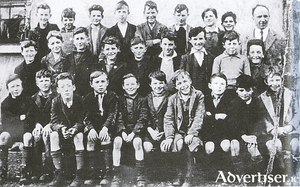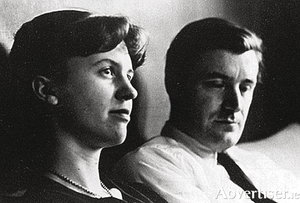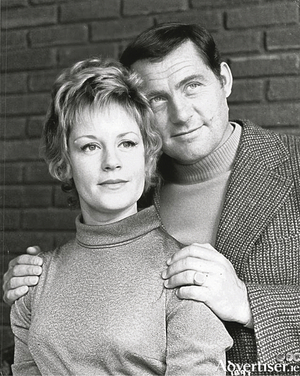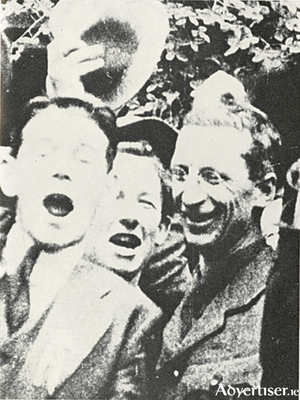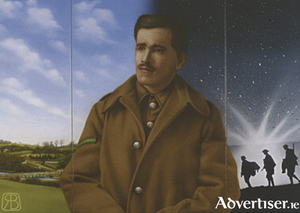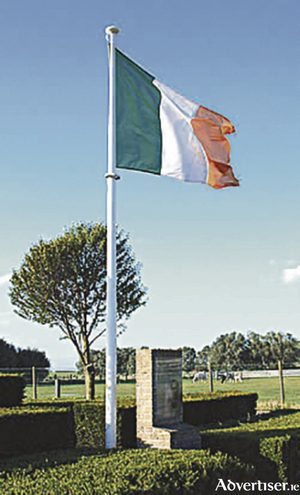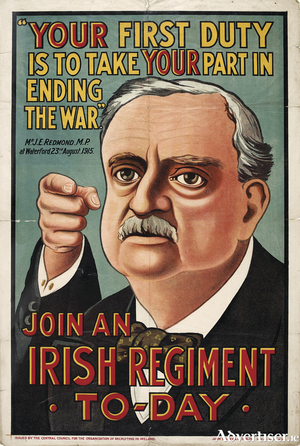From skullduggery to a fishing industry
Thu, Dec 14, 2017
We know very little about manmade piers and quays along the western seaboard before the beginning of the 19th century, when a lavish programme of safe harbours were built not only to encourage fishing, but as relief programmes in times of distress. It was also an attempt to replace the activities of piracy and smuggling with an industry based on the believed bounty from the sea.
Read more ...Drinking German tea, and other stories from South Galway.
Thu, Nov 30, 2017
Pete Lane, now in his 80s, who went to Ballindereen national school, spent most of his busy working life ‘on his knees thinning beet’. He had a friend Tommy Staunton from Lough Cutra, who had fought in World War I. Before Tommy went ‘over the top’ he was delighted when each soldier was handed a ‘little glass of brandy’. After which, Tommy claimed, you had no fear in the world. One day they were fighting the Germans, and managed to drive them out of their trenches. There they found a boiler of tea. It was still warm. The men settled down for a good cuppa but the officer warned them that the tea might be poisoned. Nobody cared if it was poisoned or not. ‘We were so exhausted an killed out’ that they enjoyed the break while the fighting continued.
Pete met his wife May in Tooreen, and brought her to the cinema in Kinvara. She was a May Carney from Clarinbridge and 20 years old. ‘There were no long engagements then. We were married in Oranmore at a very fast ceremony. Married and out the door. We had a ‘breakfast’ they called it then. We went to Dublin for a few days, then home. We worked hard, but when you are young you don’t notice it. Milking cows, feeding calves and pigs. We had hens and turkeys. You got good money for them especially at Christmas. I’d make the butter, and all the children’s clothes. I loved sewing always. Women were great. It was a different life. We had no jobs outside the home, but we had plenty to do. Non stop from morning to night, but you were well rewarded.’
Read more ...Letter from Ted Hughes to Assia’s sister, Celia Chaikin, April 14 1969
Thu, Nov 16, 2017
Week III
Dear Celia, I should have written to you long ago but I’ve felt so absolutely smashed and not capable of talking to any one about what happened (three weeks earlier, her sister Assia had gassed herself, with her four-year-old daughter, Shura,). Your letter was a lot of support to me. I always liked you in your letters, and in what Assia told me about you, and you said just what was needed .
Letter from Ted Hughes to Sylvia Plath’s mother, Aurelia, March 15, 1963
Thu, Nov 02, 2017
Dear Aurelia, It has not been possible for me to write this letter before now...
Read more ...Taking the pulse of a people....
Thu, Oct 26, 2017
Part II
‘One night there was a man and his wife and family sitting around the fire and a knock came to the door. The man was getting up to open it when someone struck him with a sod of turf on the back. A great number of fairies came in and they started beating the man and his wife and children. They brought the man away with him. After a few days, he came back to his wife and he said to her, “You can save me tomorrow night. We will have a race and I will be on the third horse and when I will be passing you out, throw a sod of turf at me and I will be saved.” Next night when he was passing her out, she threw a sod of turf at him and he was saved. The reason the fairies beat him was because he had no water in the house. He kept enough water in the house after that.’
While Europe prepares for war, Galway dances the Lindy Hop!
Thu, Oct 19, 2017
Charles Lindberg made his famous non-stop flight from the US to Europe in May 1927. A young pilot of 25 years, he flew from New York to Paris, on a plane christened The Spirit of St Louis, and his achievement was celebrated across the world. Even on the dance floor!
The Lindy Hop, later more widely known as the ‘Jitterbug’, owes its origins to Black Harlem influence, and to the granddaddy of Swing himself, Mr Shorty George Snowdon. The legend says that Shorty was watching couples dance in his club when a journalist asked him what were they dancing? A newspaper article which headlined: LINDY HOPS THE ATLANTIC was nearby. Shorty replied: ‘They are doing the Lindy Hop’.
Read more ...‘Oh steer my bark to Erin’s Isle...’
Thu, Oct 12, 2017
On Friday evening towards the end of the Easter Rising, there was one further horrific incident that convined Padraic Pearse that surrender, and quickly, was the only course open to the rebels.
Read more ...Inspirations for a poet
Thu, Sep 28, 2017
Week II
‘I could be a month telling you what happened on that night , and I wouldn’t have a tenth told, not in years if I was to tell all I went through in those eight hours fighting waves…’ began Pat Concannon who told the poet Richard Murphy about his struggle to survive the great storm of October 28 1927 when a small fleet of local fishing boats were caught off guard while hauling in nets filled with mackerel and herring. Forty-five men, from the small communities of Inishkea, Lacken, Inishboffin, and Cleggan, drowned that night. It was by far the worst sea disaster of its kind along the Connemara coast.Concannon provided an authentic account for Murphy’s lengthy poem The Cleggan Disaster, included in his Sailing to an Island collection*.
The moaning came from the room next door
Thu, Sep 21, 2017
In the early 1960s the poet Richard Murphy spent an eventful decade ferrying visitors on his converted traditional Galway hooker type boat, the Ave Maria, between Cleggan and Inishbofin, and to the islands beyond. It provided rich pickings for the poet. He kept a diary of the journeys, the characters who came on board, and the excellent fishing that anglers enjoyed, which he included in his finely observed autobiography The Kick, recently republished to celebrate his 90th birthday.*
Read more ...‘Love set you going like a fat gold watch’
Thu, Sep 14, 2017
Week V
The morning, Sunday September 16, following dinner with Tom Kinsella, Ted Hughes had gone. He told his wife Sylvia that he was going to stay with Barrie Cooke, a painter, in Co Clare, and to go fishing for salmon. Sylvia was calm. She told Richard Murphy that she would meet Hughes on the Galway to Dublin train on Wednesday.
A gentle kick under the table
Thu, Sep 07, 2017
Week IV
If Sylvia Plath was hoping for some kind of reprochement between herself and her husband Ted Hughes during their stay with Richard Murphy at Cleggan, Co Galway, she was to be quickly disillusioned. In fact she would be abandoned, and plunged into despair.
If Sylvia Plath was hoping for some kind of reprochement between herself and her husband Ted Hughes during their stay with Richard Murphy at Cleggan, Co Galway, she was to be quickly disillusioned. In fact she would be abandoned, and plunged into despair.
Read more ...Two poets bring their unhappiness to Cleggan
Thu, Aug 31, 2017
Week III
The tragic early suicide of the poet Sylvia Plath was to haunt Richard Murphy - who turned down her request to remain with him at Clegan after she was abandoned by her husband Ted Hughes. Murphy, conscious that he was a stranger in a rural society that still very much represented a Catholic ethos, and which had accepted and befriended him, would, he feared, be unforgiven if a married woman lived in his house. Of course had he known the depth of her despair, that would drive her to suicide a few months later, he would have relented. But when he realised that Hughes had walked out on her, he panicked. He said that it would be better if she went too. As he watched her get into a car to be driven to Dublin, he felt mean, and partly to blame for her misery.
The poet who went mad on Inishboffin
Thu, Aug 17, 2017
In 1959 the poet Richard Murphy renovated the black-sailed Ave Maria, a traditional Galway hooker, which he used to ferry visitors to Inishboffin, and for a day’s fishing. Over the years the poet, the boat and the magnificent landscape attracted a flotsam and jetsam of humanity, many of a literary kind.
The critically acclaimed American poet Theodore Roethke*, and his model wife Beatrice (whom he adored and addressed as ‘My lizard, my lively writher’), arrived for a few days, and stayed two months.
Read more ...Lessons from ‘an old schoolmaster’
Thu, Aug 10, 2017
Week III
There is no denying that Éamon de Valera was born in New York ( October 14 1882), and was therefore an American citizen. Following the Easter Rising, he was arrested for his role commanding his battalion at the south east approaches to Dublin at Boland’s Mills by the Grand Canal. He was sentenced to death on May 8 1916 by a military court. His wife Sinéad immediately got the American consul to intervene.
There is no denying that Éamon de Valera was born in New York ( October 14 1882), and was therefore an American citizen. Following the Easter Rising, he was arrested for his role commanding his battalion at the south east approaches to Dublin at Boland’s Mills by the Grand Canal. He was sentenced to death on May 8 1916 by a military court. His wife Sinéad immediately got the American consul to intervene.
Read more ...‘The Irish Republic is to them, a dream no longer’
Thu, Aug 03, 2017
Week II
Having first been reluctant to stand as the Sinn Féin candidate for East Clare in the summer of 1917, Éamon de Valera threw himself into the fray with enormous energy.
Éamon de Valera enters the Irish political stage
Thu, Jul 27, 2017
On June 7 1917 Major Willie Redmond, MP for East Clare, was killed in action leading the Royal Irish Brigade to victory at the Battle of Messines Ridge at Ypres. A member of the Irish Parliamentary Party (his brother John was party leader), he had represented East Clare at Westminster for 25 years. At 53 years of age Redmond was too old to be a soldier. But he was convinced that an Ireland loyal to the Crown would succeed in achieving Home Rule, and so he joined the Irish troops at Flanders.
Read more ...Under the wild sky
Thu, Jul 20, 2017
Week III
Apart from many Irish nationalists believing that Home Rule would follow if they fought for Britain; or the Ulsterman’s belief that after their sacrifice, Britain ‘would see them right,’ there were other reasons too, that drove young men into the British army at this perilous time in history. Men joined for heroic reasons. There were propaganda warnings that Irish women would be raped, land and farms confiscated, churches burnt and looted if Germany invaded Ireland as it had Belgium.
‘All the dead kings came to me’.
Thu, Jul 13, 2017
Week II
After the success of the the battle of Messines Ridge in early June 1917, the greatest military success of the war to date, the Allied army instead of pushing forward on through Flanders to the Passchendaele ridge, remained static for seven weeks. The Commander in Chief, Sir Douglas Haig, believed that the German army was on the verge of collapse, and would be broken completely by a major Allied victory. He needed time to prepare a new strategy.
A letter sent to GA Hayes-McCoy
Thu, Jul 06, 2017
One hundred years ago there were a series of truly terrible battles on the Western Front which were watched anxiously in Ireland as elsewhere. On June 7, near the Belgian village of Messines, the Allied army won a substantial victory. It gave hope, which turned out to be tragically false, that perhaps this was the beginning of the end of the war. With the capture of the Messines ridge, the Allies were confident they could clear a path all the way down to Passchendaele, and capture the Belgian coast up the Dutch border.
Read more ...
